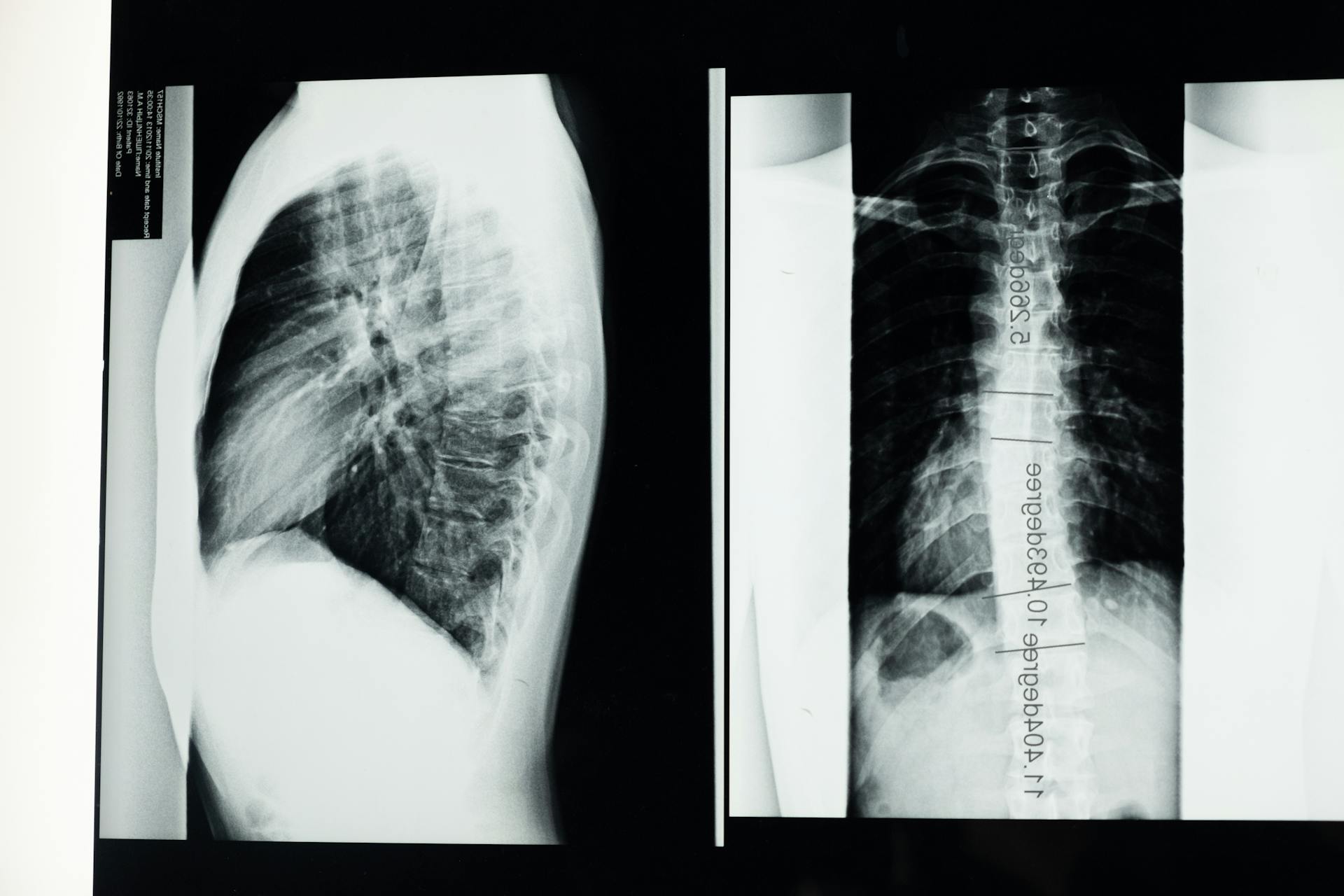
Chondrosarcoma is a type of cancer that affects dogs, specifically targeting the cartilage in their bones. It's a relatively rare form of canine cancer, but one that requires prompt attention and treatment.
Chondrosarcoma can occur in various parts of a dog's body, including their limbs, pelvis, and even their skull. This type of cancer often grows slowly, which can make it challenging to detect in its early stages.
Dogs with chondrosarcoma may exhibit symptoms such as lameness, swelling, and pain, especially in the affected area. These symptoms can be subtle at first, making it essential to monitor your dog's behavior and physical condition closely.
The age of onset for chondrosarcoma varies, but it's more common in older dogs, typically above the age of 7.
Consider reading: Benign Types of Dog Tumors
What Is Canine Cancer
Canine cancer is a serious health issue that affects many dogs. It's essential to understand the basics of canine cancer to better support our furry friends.
Chondrosarcoma, a type of bone tumor, is the second most common form of canine cancer. It can affect dogs of all ages, but is most commonly found in older dogs.
Larger breeds of dogs are more susceptible to chondrosarcoma, making breeds like Boxers and German Shepherds more prone to this cancer.
Causes of Canine Cancer
The causes of canine cancer can be complex and multifaceted. The precise cause of chondrosarcoma, a type of bone cancer in dogs, is unknown.
Body size may play a role in the development of tumors in dogs. Genetic factors may also be involved, but more research is needed to fully understand their impact.
Abnormal hormone stimulation can contribute to the development of tumors in dogs. This can lead to uncontrolled growth and the formation of cancerous cells.
Unfortunately, there is not enough known about the causes of canine cancer to identify a single underlying factor. Further research is necessary to better understand the causes and risk factors for this disease.
Explore further: Types of Dog Tumors with Pictures
What Is Cancer?
Cancer is a serious condition that affects dogs of all ages, but it's more common in older dogs. Chondrosarcoma is a type of bone tumor that's found in dogs.
Chondrosarcoma can be life threatening and the rate of survival negatively correlates with the cancer's progression upon diagnosis. This means the sooner it's detected, the better the chances of survival.
Larger breeds of dogs are more susceptible to chondrosarcoma, with Boxers and German Shepherds having the highest occurrence.
Testing and Diagnosis
A thorough physical examination is essential for diagnosing canine cancer chondrosarcoma, as it helps evaluate a dog's overall health and detect any signs of metastasis.
Bloodwork, urinalysis, and x-rays are also necessary to assess a dog's health and look for signs of metastasis.
Cytology, or collecting a sample of cells directly from the tumor, is a necessary step for diagnosing any type of cancer.
A biopsy of the tumor is essential for a definitive diagnosis.
The veterinarian will perform a thorough physical and orthopedic examination to check for abnormalities in a dog's hips, legs, shoulders, spine, joints, and bones.
A complete blood count, biochemistry profile, and urinalysis will be done to discover if a dog has any other health issues that may be causing the symptoms or need to be considered during treatment.
Tissue samples from lymph nodes will be analyzed for cancerous cells.
X-rays, computed tomography (CT) scans, nuclear bone scans, and radiographic scans will be taken to identify and diagnose the type of tumor and its progression.
A biopsy of the cancerous growth is the best tool for diagnosis, as it allows for microscopic analysis in the laboratory.
Clinical Presentation
If your dog is showing signs of a primary bone tumor, you may notice a history of acute or progressive lameness. This can be a subtle issue at first, but it can quickly progress to non-weight-bearing lameness due to bone pain or the presence of a pathologic fracture.
For another approach, see: Canine Bone Cancer Life Expectancy
A palpable bony mass is another common sign of a primary bone tumor in dogs. This means you can feel a lump or swelling in the affected area.
Localized pain is a common symptom of a primary bone tumor. This pain can vary in severity and may be caused by the tumor itself or by a pathologic fracture.
Here are some common symptoms of canine chondrosarcoma:
- Localized swellings
- Lameness
- Pain
Unfortunately, chemotherapy has not proven effective for a better outcome in cases of chondrosarcoma.
Steps to Recovery
If your dog has surgery, limit his activity and provide a comfortable, quiet place to rest during recovery. For some dogs, this may mean confining them to a comfortable crate.
Analgesics, or pain medication, might also be prescribed to manage pain and other symptoms. This can help your dog feel more comfortable during the recovery process.
Your veterinarian will prescribe painkillers to help your pet recover from surgery or to cope with the pain otherwise. Never give your dog a higher dose than prescribed.
A different take: Canine Cancer Pain Management
In the case of amputation, follow advice on how and when to reintroduce your pet to activity. Keep in mind that most dogs are able to adapt to the loss of a limb easily.
Carefully follow your veterinarian’s after care instructions, particularly regards to the site of surgery. This will help ensure a smooth and successful recovery for your dog.
Prognosis and Advice
The prognosis for dogs with nasal chondrosarcoma can vary depending on the treatment. With radiation therapy, rhinotomy, and radiation therapy combined with rhinotomy, the median survival time can range from 210 to 580 days.
It's essential to consider the specific type of chondrosarcoma, as the median survival time can differ. For example, dogs with chondrosarcoma of the ribs have a varying median survival time.
In some cases, amputation can be an effective treatment, with a median survival time of 540 days.
You might enjoy: Canine Leishmaniasis Treatment
Prognosis
The prognosis for dogs with nasal chondrosarcoma is generally poor, with a median survival time ranging from 210 to 580 days with various treatments.

Dogs with chondrosarcoma of the ribs have a more variable prognosis, but amputation can increase median survival time to 540 days.
Getting treatment as soon as possible is crucial, as the cancer advances rapidly and metastasis significantly reduces chances of survival.
In fact, there's only a 10% chance a dog will survive past a year with metastasis, and surgery may still be done but even then, there's only a 10% chance of survival.
Radiation therapy can be used to prolong life and relieve pain in cases of nasal chondrosarcoma, but it's not effective for treating the cancer itself.
In some cases, the primary tumor is removed, but the dog's chances of survival remain low, with only 2% likely to survive two years after surgery.
Ultimately, the prognosis will depend on various factors, including the size and location of the tumor, and your veterinarian will be able to provide more specific information.
Check this out: Canine Cancer Prognosis
Cancer Advice from Veterinary Professionals
Veterinary professionals can provide valuable insights into cancer diagnosis and treatment, with 70% of cancer cases in dogs being diagnosed between the ages of 10 and 15.
The most common types of cancer in dogs are lymphoma, mast cell tumors, and melanoma, which account for 30% of all canine cancer cases.
Some cancers, like osteosarcoma, are more aggressive and have a poor prognosis, with a median survival time of just 5-6 months.
A veterinarian's advice can help pet owners make informed decisions about their pet's care, and can also help identify potential risk factors for cancer, such as genetics and environmental factors.
In some cases, cancer can be prevented or delayed through regular veterinary check-ups and preventative care, such as vaccinations and parasite control.
The American Veterinary Medical Association recommends regular check-ups for pets to help identify potential health issues early on, including cancer.
Frequently Asked Questions
How fast does chondrosarcoma spread?
Chondrosarcoma growth rates vary, with most growing slowly and some rare types spreading rapidly. Rare aggressive types have a high risk of spreading to other areas of the body.
Sources
- https://www.dvm360.com/view/primary-bone-tumors-in-dogs
- https://vetster.com/en/conditions/dog/chondrosarcoma
- https://dogtime.com/dog-health/canine-cancer/2934-chondrosarcoma-canine-cancer-library
- https://wagwalking.com/condition/bone-cancer-chondrosarcoma
- https://www.acvs.org/small-animal/bone-tumors-in-cats-and-dogs/
Featured Images: pexels.com


